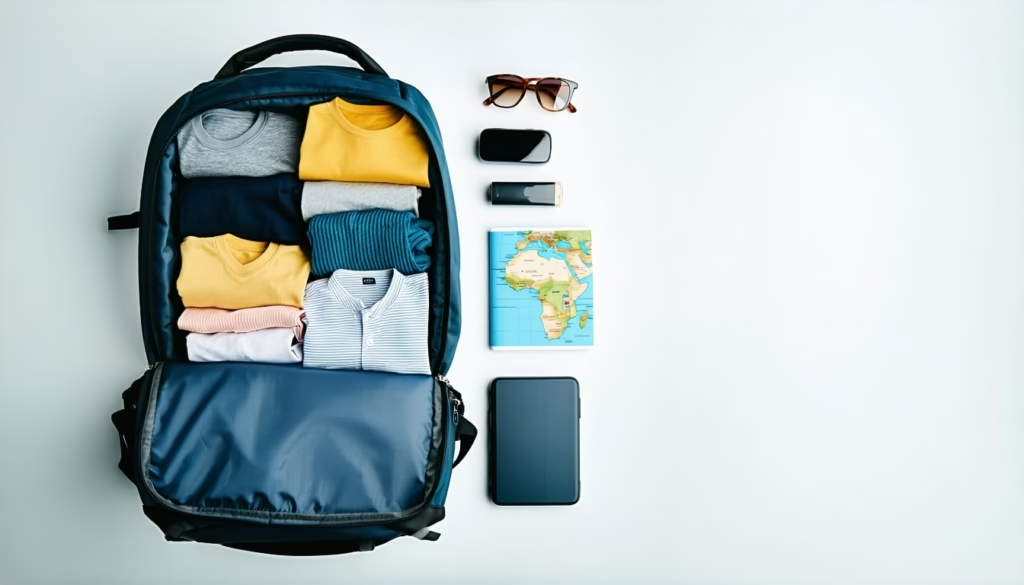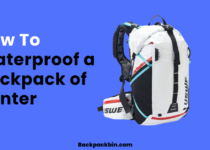How To Pack For Long Trips with Minimal Luggage

Getting ready for a long trip can feel like overpacking is practically inevitable, but learning how to pack for long trips with minimal luggage changes everything. By zeroing in on must-haves and ditching “just in case” extras, you’ll breeze through security checks, skip extra baggage fees and stay nimble on the go. Here’s the thing, you don’t need half your closet to explore for days on end.
You might be asking, how do you fit two weeks of stuff into one backpack? In this step by step tutorial, you’ll discover how to choose the perfect pack, plan outfit rotations and apply simple hacks to squeeze everything in without extra bulk. Let’s dive in.
Assess Your Essentials
Start by listing the items you absolutely need, nothing more. That keeps your mind clear and prevents impulse packing. Your essentials list might look like this:
- Travel documents, wallet and ID
- Phone, charger and power bank
- Lightweight tops, underwear and socks
- One pair of versatile bottoms
- Basic toiletries (toothbrush, toothpaste, deodorant)
- Medications and first-aid items
What could you leave behind if you really had to carry all your gear? Making tough choices up front will save major space later. Focus on multipurpose pieces—items that pull double duty wherever possible.
Choose Ideal Backpack
Picking the right backpack is step one in packing smart. A 30 to 40 liter pack usually balances capacity and comfort. Look for durable fabric, water resistance and padded straps. How do you pick the right bag for a two week trek? Here are the key features to check:
- 30–40L capacity to fit 7–14 days of essentials
- Multiple compartments for easy organization
- Compression straps to reduce bulk
- Padded back panel and straps for comfort
- Laptop or document sleeve if you work on the go
Weigh your empty bag before filling it—lighter is better once you add gear. Use this quick reference table to compare features:
| Feature | Benefit |
|---|---|
| 35L Capacity | Holds 7–10 days of clothing |
| Compression Straps | Compress bulky items to save space |
| Multiple Pockets | Separate gear, tech and toiletries |
| Padded Harness | Reduces shoulder strain |
For a closer look at top models, check out our best travel backpacks with built-in packing compartments.
Plan Outfit Rotation
When you plan an outfit rotation, you get more wears from fewer pieces. Start by choosing neutral colors that mix and match. Can you get by with five shirts on a ten day trip? Absolutely, if you follow these tips:
- Pick versatile bottoms (jeans, leggings or convertible pants)
- Choose neutral tops that layer under jackets
- Rotate accessories like scarves or jewelry to change looks
- Limit bulky items to one outer layer
For cold climates, layer up instead of packing multiple bulky coats. Our step-by-step guide to layering clothes efficiently when packing shows you exactly how to build outfits that adapt to any weather.
Optimize Clothing Packing
When it comes to clothing, how you fold or roll matters. Should you roll or fold or both? Let’s break it down:
Fold Or Roll Smart
Rolling clothes saves space and prevents major wrinkles. Folding works for stiffer items like button-down shirts. Here’s a quick rule:
- Roll soft items (t-shirts, leggings, underwear)
- Fold semi-structured garments (chinos, polos)
- Combine both methods to fill corners and pockets
Want more folding vs rolling advice? Check out our how to roll vs fold clothes for maximum suitcase space.
Pack Bulky Layers
Bulky sweaters and jackets can eat up half your pack if you’re not careful. How do you tackle those heavy pieces? Try these tactics:
- Wear your heaviest layer on travel days to free up space
- Compress bulky items into external straps or the top pocket
- Stuff sleeves and pockets with socks or small items for shape
For detailed tips, see our guide on how to pack bulky sweaters and jackets efficiently.
Pack Toiletries Efficiently
Toiletries can leak or take up prime real estate in your pack, so handle them with care. Can you really fit shampoo, toothpaste and skincare into a small pouch? Yes, with these tips:
- Opt for travel-sized bottles under 3.4 ounces (100 milliliters)
- Use reusable silicone bottles and label them clearly
- Pack liquids in a waterproof zip pouch or clear bag
- Consider solid shampoo bars and bar soap to cut bottle bulk
Arrange your toiletry pouch near the top of your backpack for easy security checks and quick access on the road. Seal each bottle’s lid with a small piece of plastic wrap under the cap to prevent leaks.
Organize Tech And Accessories
Your tech gear can end up tangled and wasted space if you’re not careful. Got more chargers than hands? Try these tricks:
- Use a compact cable organizer or zip pouch
- Remove bulky packaging and carry only essential adapters
- Charge tech items fully and pack a lightweight power bank
- Store spare batteries in sealed plastic cases
Keep your phone, camera and battery pack in an easy-access pocket so you’re never digging for power. For more ideas on gear organization, check out our how to fit tech gadgets and chargers without clutter.
Use Space Saving Tools
You don’t need high tech gear to boost your pack’s capacity. Can a couple of simple tools turn your packing game on its head? Absolutely:
- Packing cubes to group items by category
- Compression sacks or bags to flatten bulky clothes
- Shoe bags to isolate footwear and save liner space
Packing cubes keep everything organized so you can pull out an outfit without emptying your bag. For ultimate organization, see our guide on packing cubes for ultimate luggage organization. If you want even more compression, try reusable vacuum bags (just remember they add weight).
Separate Dirty Clothes
Nothing ruins a clean load faster than a sweaty t-shirt rubbing against your fresh socks. Dreading the mix of clean and dirty clothes in your bag? Stay ahead with these simple hacks:
- Pack a lightweight laundry bag or reusable cloth pouch
- Seal worn items in odor-resistant bags
- Wash small items in a sink mid trip to reduce dirty load
- Schedule a quick laundry stop on extended routes
By keeping dirty items sealed, you protect the rest of your gear from smells and stains. Plus, you’ll avoid that cringe moment when you reach for a fresh shirt only to find your last clean pair of socks… missing.
Final Packing Checklist
Before you swing that backpack over your shoulder, run through this final checklist to make sure you’ve covered all bases:
| Category | Key Items | Where To Pack |
|---|---|---|
| Clothing | 5 tops, 3 bottoms, underwear, socks | Main compartment |
| Outerwear | Lightweight jacket or sweater | Top pocket or straps |
| Toiletries | Travel bottles, toothbrush, bar soap | Front compartment |
| Tech | Phone, charger, power bank | Tech pocket |
| Dirty Laundry | Reusable laundry bag | Side or external pocket |
Now zip it up, give it a good shake and you’re ready to roll.
Frequently Asked Questions
How Do I Choose The Right Backpack Size For A Long Trip?
Aim for a 30 to 40 liter pack. That capacity usually handles 7 to 14 days of gear without feeling bulky. Check for padded straps, multiple compartments and water-resistant fabric. Always load it up at home to test comfort before you head out.
Can I Really Travel With Just One Backpack?
Yes, you can travel with a single pack if you plan carefully. Focus on versatile clothing, wash items mid trip and limit nonessentials. Wearing your bulkiest layer on travel days also frees up prime space in your bag.
What Are The Best Clothing Materials For Packing Light?
Merino wool and synthetic blends beat cotton for travel. They wick moisture, resist odor and dry quickly. Pick quick-dry fabrics for tops and layering pieces so you can wash and re-wear without a bulky pile of dirty clothes.
How Can I Handle Dirty Laundry On The Road?
Pack a lightweight laundry bag or reusable pouch. Seal worn items in odor-resistant bags to protect clean clothes. Consider laundry sheets or pods if you’ll wash in sinks or laundromats. Planning a mid-trip laundry stop can also keep your load light.
Are Compression Bags Worth The Extra Effort?
Compression bags can reduce bulky items by up to 50 percent, but they add weight and require manual squeezing. If you need maximum volume for jackets or sweaters, they’re great. For everyday packing, lightweight packing cubes may be an easier choice.
How Do I Keep Electronics Safe When Traveling Light?
Store devices in a padded tech pocket or small pouch. Use a cable organizer to prevent tangles. Always pack chargers and power banks in easily accessible spots so you can recharge on the go without digging through layers.
Final Thoughts And Recommendations
Packing for long trips with minimal luggage is as much about mindset as gear. When you focus on essentials, pick the right backpack and master rolling and storage tools, you’ll travel lighter and stress less. On your next journey, try wearing your bulkiest layer on the plane, rolling your tees and using packing cubes. You might be surprised by how much space you free up.
Give these tips a test run and see the difference for yourself. If one trick really makes your packing easier, share it in the comments below or pass this article along to a friend who loves to travel light. Happy travels!


